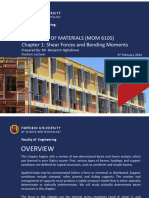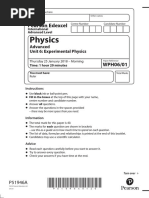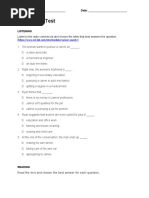Lecture
Lecture
Uploaded by
Rohit PareekCopyright:
Available Formats
Lecture
Lecture
Uploaded by
Rohit PareekOriginal Title
Copyright
Available Formats
Share this document
Did you find this document useful?
Is this content inappropriate?
Copyright:
Available Formats
Lecture
Lecture
Uploaded by
Rohit PareekCopyright:
Available Formats
Lecture 25 and 26
http://nptel.iitm.ac.in/courses/Webcourse-contents/IIT-ROORKEE/stren...
LECTURE 25 and 26
Simple Bending Theory OR Theory of Flexure for Initially Straight Beams (The normal stress due to bending are called flexure stresses) Preamble: When a beam having an arbitrary cross section is subjected to a transverse loads the beam will bend. In addition to bending the other effects such as twisting and buckling may occur, and to investigate a problem that includes all the combined effects of bending, twisting and buckling could become a complicated one. Thus we are interested to investigate the bending effects alone, in order to do so, we have to put certain constraints on the geometry of the beam and the manner of loading. Assumptions: The constraints put on the geometry would form the assumptions: 1. Beam is initially straight , and has a constant cross-section. 2. Beam is made of homogeneous material and the beam has a longitudinal plane of symmetry. 3. Resultant of the applied loads lies in the plane of symmetry. 4. The geometry of the overall member is such that bending not buckling is the primary cause of failure. 5. Elastic limit is nowhere exceeded and E' is same in tension and compression. 6. Plane cross - sections remains plane before and after bending.
Let us consider a beam initially unstressed as shown in fig 1(a). Now the beam is subjected to a constant bending moment (i.e. Zero Shearing Force') along its length as would be obtained by applying equal couples at each end. The beam will bend to the radius R as shown in Fig 1(b) As a result of this bending, the top fibers of the beam will be subjected to tension and the bottom to compression it is reasonable to suppose, therefore, that some where between the two there are points at which the stress is zero. The locus of all such points is known as neutral axis . The radius of curvature R is then measured to this axis. For symmetrical sections the N. A. is the axis of symmetry but what ever the section N. A. will always pass through the centre of the area or centroid. The above restrictions have been taken so as to eliminate the possibility of 'twisting' of the beam.
Concept of pure bending:
Loading restrictions: As we are aware of the fact internal reactions developed on any cross-section of a beam may consists of a resultant normal force, a resultant shear force and a resultant couple. In order to ensure that the bending effects alone are investigated, we shall put a constraint on the loading such that the resultant normal and the resultant shear forces are zero on any cross-section perpendicular to the longitudinal axis of the member,
1 of 8
9/8/2011 3:39 PM
Lecture 25 and 26
http://nptel.iitm.ac.in/courses/Webcourse-contents/IIT-ROORKEE/stren...
That means F = 0 since or M = constant.
Thus, the zero shear force means that the bending moment is constant or the bending is same at every cross-section of the beam. Such a situation may be visualized or envisaged when the beam or some portion of the beam, as been loaded only by pure couples at its ends. It must be recalled that the couples are assumed to be loaded in the plane of symmetry.
When a member is loaded in such a fashion it is said to be in pure bending. The examples of pure bending have been indicated in EX 1and EX 2 as shown below :
2 of 8
9/8/2011 3:39 PM
Lecture 25 and 26
http://nptel.iitm.ac.in/courses/Webcourse-contents/IIT-ROORKEE/stren...
When a beam is subjected to pure bending are loaded by the couples at the ends, certain cross-section gets deformed and we shall have to make out the conclusion that, 1. Plane sections originally perpendicular to longitudinal axis of the beam remain plane and perpendicular to the longitudinal axis even after bending , i.e. the cross-section A'E', B'F' ( refer Fig 1(a) ) do not get warped or curved. 2. In the deformed section, the planes of this cross-section have a common intersection i.e. any time originally parallel to the longitudinal axis of the beam becomes an arc of circle.
We know that when a beam is under bending the fibres at the top will be lengthened while at the bottom will be shortened provided the bending moment M acts at the ends. In between these there are some fibres which remain unchanged in length that is they are not strained, that is they do not carry any stress. The plane containing such fibres is called neutral surface. The line of intersection between the neutral surface and the transverse exploratory section is called the neutral axisNeutral axis (N A) .
Bending Stresses in Beams or Derivation of Elastic Flexural formula :
In order to compute the value of bending stresses developed in a loaded beam, let us consider the two cross-sections of a beam HE and GF , originally parallel as shown in fig 1(a).when the beam is to bend it is assumed that these sections remain parallel i.e. H'E' and G'F' , the final position of the sections, are still straight lines, they then subtend some angle q. Consider now fiber AB in the material, at adistance y from the N.A, when the beam bends this will stretch to A'B'
Since CD and C'D' are on the neutral axis and it is assumed that the Stress on the neutral axis zero. Therefore, there won't be any strain on the neutral axis
3 of 8
9/8/2011 3:39 PM
Lecture 25 and 26
http://nptel.iitm.ac.in/courses/Webcourse-contents/IIT-ROORKEE/stren...
Consider any arbitrary a cross-section of beam, as shown above now the strain on a fibre at a distance y' from the N.A, is given by the expression
Now the term denoted by a symbol I. Therefore
is the property of the material and is called as a second moment of area of the cross-section and is
This equation is known as the Bending Theory Equation.The above proof has involved the assumption of pure bending without any shear force being present. Therefore this termed as the pure bending equation. This equation gives distribution of stresses which are normal to cross-section i.e. in x-direction. Section Modulus: From simple bending theory equation, the maximum stress obtained in any cross-section is given as
For any given allowable stress the maximum moment which can be accepted by a particular shape of cross-section is therefore
4 of 8
9/8/2011 3:39 PM
Lecture 25 and 26
http://nptel.iitm.ac.in/courses/Webcourse-contents/IIT-ROORKEE/stren...
For ready comparison of the strength of various beam cross-section this relationship is some times written in the form Is termed as section modulus The higher value of Z for a particular cross-section, the higher the bending moment which it can withstand for a given maximum stress. Theorems to determine second moment of area: There are two theorems which are helpful to determine the value of second moment of area, which is required to be used while solving the simple bending theory equation.
Second Moment of Area :
Taking an analogy from the mass moment of inertia, the second moment of area is defined as the summation of areas times the distance squared from a fixed axis. (This property arised while we were driving bending theory equation). This is also known as the moment of inertia. An alternative name given to this is second moment of area, because the first moment being the sum of areas times their distance from a given axis and the second moment being the square of the distance or .
Consider any cross-section having small element of area d A then by the definition Ix(Mass Moment of Inertia about x-axis) = and Iy(Mass Moment of Inertia about y-axis) =
Now the moment of inertia about an axis through O' and perpendicular to the plane of figure is called the polar moment of inertia. (The polar moment of inertia is also the area moment of inertia). i.e, J = polar moment of inertia
The relation (1) is known as the perpendicular axis theorem and may be stated as follows: The sum of the Moment of Inertia about any two axes in the plane is equal to the moment of inertia about an axis perpendicular to the plane, the three axes being concurrent, i.e, the three axes exist together. CIRCULAR SECTION : For a circular x-section, the polar moment of inertia may be computed in the following manner
5 of 8
9/8/2011 3:39 PM
Lecture 25 and 26
http://nptel.iitm.ac.in/courses/Webcourse-contents/IIT-ROORKEE/stren...
Consider any circular strip of thickness dr located at a radius 'r'. Than the area of the circular strip would be dA = 2pr. dr Thus
Parallel Axis Theorem: The moment of inertia about any axis is equal to the moment of inertia about a parallel axis through the centroid plus the area times the square of the distance between the axes.
6 of 8
9/8/2011 3:39 PM
Lecture 25 and 26
http://nptel.iitm.ac.in/courses/Webcourse-contents/IIT-ROORKEE/stren...
If ZZ' is any axis in the plane of cross-section and XX' is a parallel axis through the centroid G, of the cross-section, then
Rectangular Section: For a rectangular x-section of the beam, the second moment of area may be computed as below :
Consider the rectangular beam cross-section as shown above and an element of area dA , thickness dy , breadth B located at a distance y from the neutral axis, which by symmetry passes through the centre of section. The second moment of area I as defined earlier would be
Thus, for the rectangular section the second moment of area about the neutral axis i.e., an axis through the centre is given by
7 of 8
9/8/2011 3:39 PM
Lecture 25 and 26
http://nptel.iitm.ac.in/courses/Webcourse-contents/IIT-ROORKEE/stren...
Similarly, the second moment of area of the rectangular section about an axis through the lower edge of the section would be found using the same procedure but with integral limits of 0 to D .
Therefore
These standards formulas prove very convenient in the determination of INA for build up sections which can be conveniently divided into rectangles. For instance if we just want to find out the Moment of Inertia of an I - section, then we can use the above relation.
Goto Home
8 of 8
9/8/2011 3:39 PM
You might also like
- PPL (H) : Part-FCL Question BankDocument42 pagesPPL (H) : Part-FCL Question BankChance 101No ratings yet
- Beams: Mu Ø MNDocument12 pagesBeams: Mu Ø MNWalter CatapangNo ratings yet
- Sigmund Freud The Correspondence of Sigmund Freud and Sandor Ferenczi Volume 1, 1908-1914Document619 pagesSigmund Freud The Correspondence of Sigmund Freud and Sandor Ferenczi Volume 1, 1908-1914myemanation100% (14)
- Unit 2 - Compass CorrectionDocument81 pagesUnit 2 - Compass CorrectionUtpal Kant100% (2)
- Lecture 25 and 26Document8 pagesLecture 25 and 26ardikurniawanNo ratings yet
- Simple Bending TheoryDocument11 pagesSimple Bending TheoryAnonymous 2RduvkjgZNo ratings yet
- IC24Document7 pagesIC24DrSn PadhiNo ratings yet
- Bending TheoryDocument5 pagesBending TheoryNeelam KapoorNo ratings yet
- Strengths 3rd ChapterDocument10 pagesStrengths 3rd Chapteryodahe aberaNo ratings yet
- Pure BendingDocument22 pagesPure BendingTarik Hassan ElsonniNo ratings yet
- Prof TVKB SOM Lecture 07 Stresses BeamsDocument63 pagesProf TVKB SOM Lecture 07 Stresses BeamstvkbhanuprakashNo ratings yet
- Pure BendingDocument38 pagesPure BendingMalik Rehan SyedNo ratings yet
- Mech Sol ch7Document16 pagesMech Sol ch7akshatbhargavaNo ratings yet
- Stress Analysis in Elastic Bending Beams and Thick Hollow CylindersDocument6 pagesStress Analysis in Elastic Bending Beams and Thick Hollow Cylindersمحمد فطري فيك نظامNo ratings yet
- Use of Flexure Formula:: Illustrative ProblemsDocument6 pagesUse of Flexure Formula:: Illustrative ProblemsKaiser CarloNo ratings yet
- 3.stress in BeamsDocument38 pages3.stress in BeamsAbi DemNo ratings yet
- Bending StressDocument16 pagesBending Stresspalash1401No ratings yet
- Stresses in BeamDocument13 pagesStresses in BeammaloyNo ratings yet
- Chapter13 PDFDocument60 pagesChapter13 PDFRemitesh JosephNo ratings yet
- Chapter 2 Lecture NoteDocument19 pagesChapter 2 Lecture NoteeyobNo ratings yet
- Design and Construction of A Structure For A Three Point Bending TestDocument13 pagesDesign and Construction of A Structure For A Three Point Bending TestIñigoNo ratings yet
- Bending Stresses in BeamsDocument30 pagesBending Stresses in BeamsdvarsastryNo ratings yet
- CH 05Document72 pagesCH 05LeonardoMadeira110% (1)
- Som Unit - IIIDocument32 pagesSom Unit - IIIiliyasiliyas6721No ratings yet
- 23AE60R01 Expt5 AerospaceStructuresLaboratoryDocument8 pages23AE60R01 Expt5 AerospaceStructuresLaboratorySuhasNo ratings yet
- Mechanics of Materials-MENG 313Document45 pagesMechanics of Materials-MENG 313Kelly GbandehNo ratings yet
- Bending Stress in Symmetrical SectionDocument10 pagesBending Stress in Symmetrical SectionKayfe sayfadeen100% (1)
- Outcome 01 t1Document12 pagesOutcome 01 t1alexandre_motta_3No ratings yet
- Strength of MaterialDocument163 pagesStrength of MaterialJackKiaNo ratings yet
- Chapter 4-Part I - 2023Document70 pagesChapter 4-Part I - 2023mageba.artworldNo ratings yet
- UNIT-3 Strength of MaterialDocument127 pagesUNIT-3 Strength of Materialakashtripathi0292No ratings yet
- Verification of Bending Stress and Shear Stress Distribution Across The Depth For Slender BeamDocument6 pagesVerification of Bending Stress and Shear Stress Distribution Across The Depth For Slender BeamAditiDeshpandeNo ratings yet
- Analysis of StructuresDocument24 pagesAnalysis of Structuresa_j_sanyal259No ratings yet
- Bending MomentDocument12 pagesBending Momenthazheer1100% (2)
- Simplebending March 17 and 24Document23 pagesSimplebending March 17 and 24Tugce ZorluNo ratings yet
- Deflection of Beams PDFDocument28 pagesDeflection of Beams PDFBrave Hlulani MabasoNo ratings yet
- 6 BeamsDocument116 pages6 BeamsIrish TambisNo ratings yet
- Curved Prestressed BeamDocument5 pagesCurved Prestressed Beama96lhfNo ratings yet
- Chapter 7 unsymmetrical bendingDocument33 pagesChapter 7 unsymmetrical bendingPauli TeshomeNo ratings yet
- Bending and Shear Stresses in BeamDocument20 pagesBending and Shear Stresses in BeamJiya ShindeNo ratings yet
- Verifying of A Fuselage Frame Symmetrically LoadedDocument29 pagesVerifying of A Fuselage Frame Symmetrically LoadedbaburanjanNo ratings yet
- Outcome1 T1 PDFDocument12 pagesOutcome1 T1 PDFM RoyNo ratings yet
- Chapter 2 For STMDocument14 pagesChapter 2 For STMhaymanotNo ratings yet
- Pure Bending of BeamsDocument5 pagesPure Bending of BeamsManish DasNo ratings yet
- Verification of Bending Stress and Shear Stress Distribution Across The Depth For Slender BeamDocument7 pagesVerification of Bending Stress and Shear Stress Distribution Across The Depth For Slender BeamAditiDeshpandeNo ratings yet
- Bending Stress & Shear StressDocument94 pagesBending Stress & Shear StressManoj CmNo ratings yet
- Beams and ColumnsDocument12 pagesBeams and ColumnsDarius MegamindNo ratings yet
- U3 Moment of Interia Introduction and NumericalsDocument41 pagesU3 Moment of Interia Introduction and NumericalsShreyas RavichandranNo ratings yet
- Chapter Five: BendingDocument14 pagesChapter Five: BendingDexterneohhongweiNo ratings yet
- UntitledDocument9 pagesUntitledEdward NaanmaNo ratings yet
- Parallel Axis Theorem, Shear Stress and Bending Stress in Beams 9th August 2023Document7 pagesParallel Axis Theorem, Shear Stress and Bending Stress in Beams 9th August 2023sk.evan20No ratings yet
- Members Subjected To Torsional LoadsDocument8 pagesMembers Subjected To Torsional LoadsRahulkumarchauhanNo ratings yet
- Unit 1Document8 pagesUnit 1harinathNo ratings yet
- Chapter 3Document38 pagesChapter 3Gebremeskel ShimelsNo ratings yet
- Chapter 1 - Shear Forces and Bending MomentsDocument27 pagesChapter 1 - Shear Forces and Bending Momentslinus 24kNo ratings yet
- Torsion 123Document13 pagesTorsion 123Roel LopezNo ratings yet
- Flexural StressesDocument27 pagesFlexural StressesyagnikpravinbhaiNo ratings yet
- Stresses in Beams: JU. Dr. Ibrahim Abu-AlshaikhDocument20 pagesStresses in Beams: JU. Dr. Ibrahim Abu-AlshaikhqusayNo ratings yet
- Torsion of Circular Sections: Recitation #6 October 14, 2003Document12 pagesTorsion of Circular Sections: Recitation #6 October 14, 2003Krm ChariNo ratings yet
- Elastic Stability of ColumnsDocument11 pagesElastic Stability of ColumnsSayantan GhosalNo ratings yet
- Concept of Shear Force and Bending Moment in BeamsDocument40 pagesConcept of Shear Force and Bending Moment in BeamsAshutosh KushwanshiNo ratings yet
- Scam Solved ProblemsDocument5 pagesScam Solved ProblemsSadhana SureshNo ratings yet
- Sri Shiv Raksha StotraDocument3 pagesSri Shiv Raksha StotraVikrant KumarNo ratings yet
- Environmental Policy 2020Document1 pageEnvironmental Policy 2020bosemahatmaNo ratings yet
- Manual Xbox 360 Slim 4gb PDFDocument78 pagesManual Xbox 360 Slim 4gb PDFodali batistaNo ratings yet
- Server 2003Document3 pagesServer 2003gruzdasNo ratings yet
- Empowerment Technology REVISED Lesson 1 17finalDocument127 pagesEmpowerment Technology REVISED Lesson 1 17finalJefferson Medinaceli Malayao100% (9)
- lc3 IntroDocument17 pageslc3 IntroJustine Rome ArdepuelaNo ratings yet
- Power System Stability: Prof. M Venkateswara RaoDocument56 pagesPower System Stability: Prof. M Venkateswara RaochinnaNo ratings yet
- Physics: Pearson EdexcelDocument20 pagesPhysics: Pearson EdexcelNyraStardollNo ratings yet
- Teletalk Shotoborsho Package _ All Exciting OffersDocument3 pagesTeletalk Shotoborsho Package _ All Exciting OffersTItuSaAMI ShAHINNo ratings yet
- EFFECTIVENESS OF BANANA PEEL EXTRACT AS AN ECO FRIENDLY FLOOR WAX A QUANTITATIVE ANALYSIS. Stem 1Document16 pagesEFFECTIVENESS OF BANANA PEEL EXTRACT AS AN ECO FRIENDLY FLOOR WAX A QUANTITATIVE ANALYSIS. Stem 1anamariejosettcocheroNo ratings yet
- CP I-O ModulesDocument91 pagesCP I-O ModulesVlad ChioreanNo ratings yet
- Autocad Graphical User Interface: 1. Quick Access Toolbar-In Above Window You Are Not Able To See Quick AccessDocument6 pagesAutocad Graphical User Interface: 1. Quick Access Toolbar-In Above Window You Are Not Able To See Quick AccessNeil Ivan FlorencioNo ratings yet
- BUSI MATH-DLP April 4Document6 pagesBUSI MATH-DLP April 4Roy De GuzmanNo ratings yet
- Strength and of Pond Ash ConcreteDocument29 pagesStrength and of Pond Ash ConcreteNaveed BNo ratings yet
- A Sorrowful Woman Gayle GodwinDocument4 pagesA Sorrowful Woman Gayle GodwinAyeshaNo ratings yet
- Schedule A Indore Ring Road Package-1 - 2023!12!07Document28 pagesSchedule A Indore Ring Road Package-1 - 2023!12!07Shalini BorkerNo ratings yet
- XML Parser Using Modern C++ & STL Student - Mini - Project - ProposalDocument2 pagesXML Parser Using Modern C++ & STL Student - Mini - Project - Proposalsagar salankeNo ratings yet
- Diagnostic Test: Listen To The Radio Commercial and Choose The Letter That Best Answers The Question.Document3 pagesDiagnostic Test: Listen To The Radio Commercial and Choose The Letter That Best Answers The Question.titodikNo ratings yet
- Exercise 4.1 Informal Fallacies: ExercisesDocument4 pagesExercise 4.1 Informal Fallacies: ExercisesgetoNo ratings yet
- Hydraulic Single-Acting Balanced Rotary Actuator 90° (Quarter-Turn) Fail-SafeDocument3 pagesHydraulic Single-Acting Balanced Rotary Actuator 90° (Quarter-Turn) Fail-SafeLanceal TanNo ratings yet
- NI Film Showing Guide Questions 1Document2 pagesNI Film Showing Guide Questions 1Lassie AbusadoNo ratings yet
- Soal SemesterDocument5 pagesSoal SemesterWayan HamalNo ratings yet
- American Animation at First World WarDocument16 pagesAmerican Animation at First World WarSylwia KaliszNo ratings yet
- Daily Habits GuideDocument17 pagesDaily Habits GuideJOanaNo ratings yet
- Chapter 14 15 16 PDFDocument158 pagesChapter 14 15 16 PDFTommie100% (2)
- Customer Service TrainingDocument23 pagesCustomer Service TrainingHardeep SinghNo ratings yet
- Paper-2 With Solution: Jee Advanced PatternDocument28 pagesPaper-2 With Solution: Jee Advanced PatternIshaan jainNo ratings yet

























































































